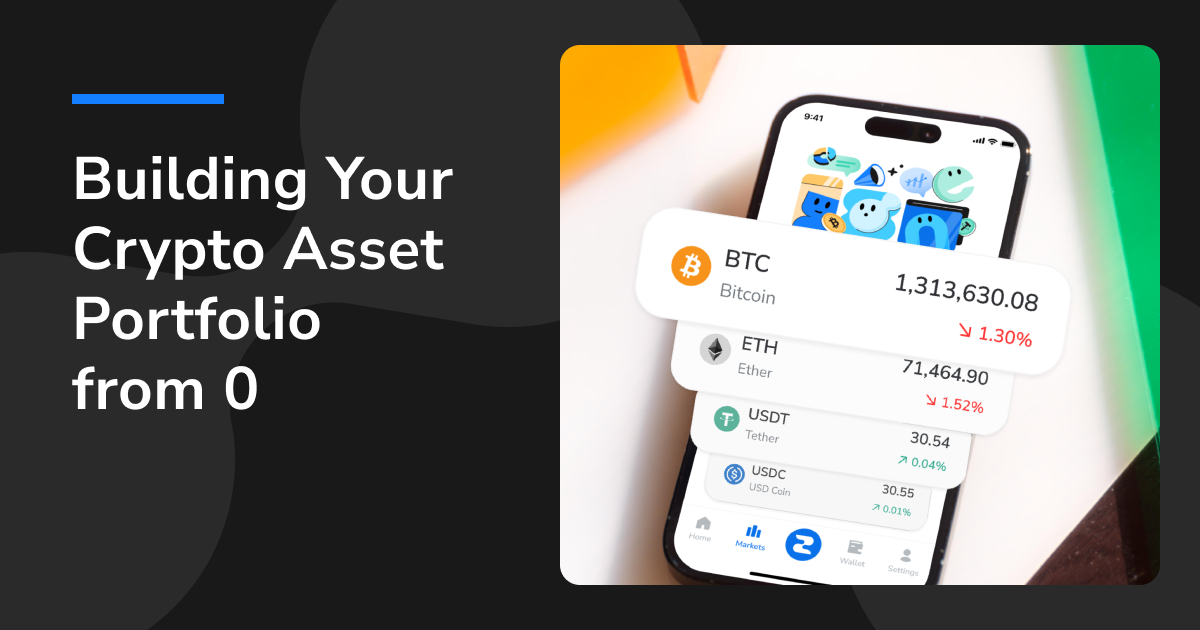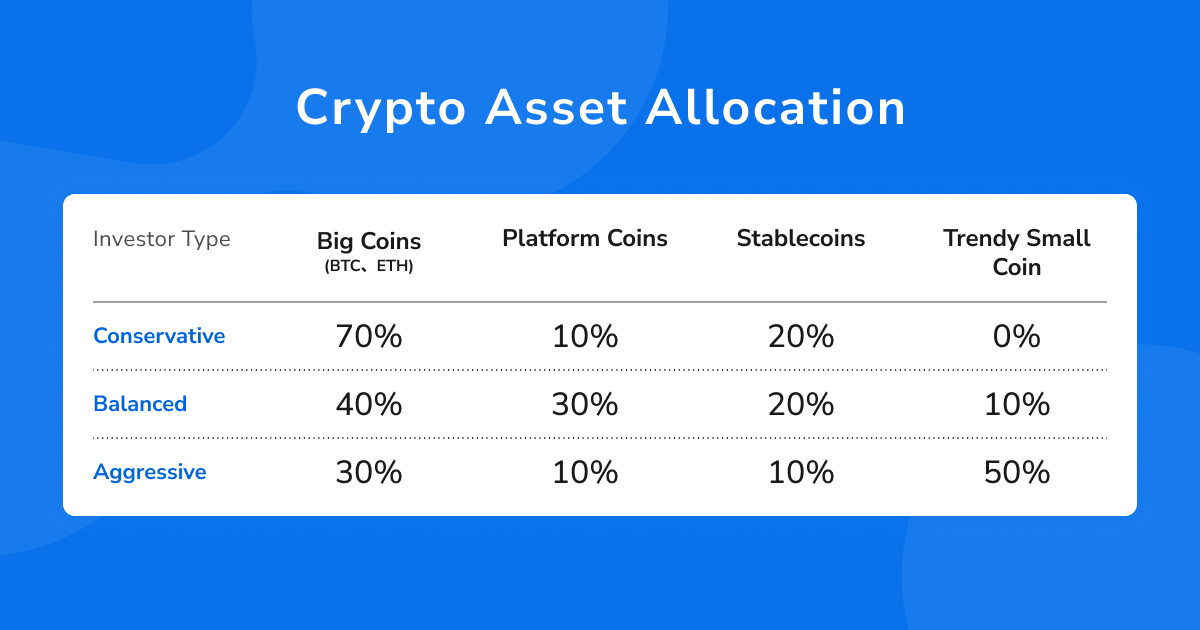Building Your Crypto Asset Portfolio from Scratch: Become a Survivor in the Crypto World

What Is a Cryptocurrency Asset Portfolio?
A cryptocurrency asset portfolio refers to an investment strategy that allocates capital across various digital assets based on your risk tolerance and investment goals. By diversifying across multiple types of cryptocurrencies, the aim is to reduce risk and smooth out volatility.In traditional finance, a common asset allocation might look like 60% stocks, 30% bonds, and 10% cash. Similarly, in the crypto world, you can allocate your funds based on token functionality and risk level.A well-structured crypto portfolio typically includes the following types of tokens:
Bitcoin (BTC)
The largest cryptocurrency by market cap, often referred to as "digital gold." It has relatively lower volatility and is considered a safe-haven asset. Typically, BTC serves as a core holding to stabilize the portfolio.
Ethereum (ETH)
The second-largest crypto asset and the native token of the Ethereum blockchain. As one of the most critical Layer 1 blockchains, ETH supports smart contracts and many decentralized applications (dApps). It offers high liquidity and growth potential.
Stablecoins (USDT, USDC)
These are cryptocurrencies pegged to fiat currencies like the U.S. dollar. Their stable value makes them ideal for use as the "cash" portion of your portfolio, providing liquidity buffers and preserving value during market swings. They can also be staked or lent out for passive income.
Platform Tokens (BNB, HT)
Issued by crypto exchanges or blockchain platforms, platform tokens offer utility such as fee discounts or access to ecosystem features. Their performance is tied to the platform's growth and user adoption, placing them in the medium-risk asset category.
DeFi Tokens (Uniswap, AAVE)
Tokens from decentralized finance (DeFi) projects. These represent blockchain-based financial applications with potential for growth—but also carry higher risk. It's important to monitor project fundamentals and liquidity metrics.
Layer 1 / Layer 2 Blockchain Tokens
Beyond BTC and ETH, this includes other Layer 1s like Cardano (ADA), Solana (SOL), and Layer 2 scaling solutions like Polygon (MATIC), Arbitrum (ARB). These are often emerging or secondary assets with innovative technologies or niche applications. They have real-world use cases and high growth potential, but also come with moderate to high volatility.
Meme Coins (DOGE, SHIB)
Tokens driven by internet memes or community hype. These coins usually lack strong fundamentals and experience extreme price swings. They are high-risk speculative assets and should be used in very small proportions—if at all.
Portfolio Construction: 5 Steps to Building a Diversified Crypto Strategy
1. Assess Your Risk Tolerance
A. Age
• 20–35 years: Longer time horizon, higher ability to absorb short-term losses.
• 36–45 years: Growing financial responsibilities; investment should focus on stability.
• 46+ years: Capital preservation and income become the main goals; avoid highly volatile assets.
B. Financial Status
• Is your income stable? If not, increase your stablecoin allocation or delay investing to avoid liquidity stress.
• Have you set aside emergency funds? At least 3–6 months of living expenses should be kept in reserve. All investment capital should be "idle money" that won’t affect your quality of life if lost.
2. Define Your Investment Goals
•Long-term capital growth and financial freedom: Suitable for DCA (Dollar-Cost Averaging) and long-term holding, focusing on major crypto assets (BTC, ETH).
•Short-term profit maximization: Focus on risk control and target high-volatility assets.
•Stable returns or capital preservation: Consider stablecoin yield products or holding BTC as a hedge against fiat depreciation.
3. Select Asset Types and Token Allocation
Based on your risk profile, decide which categories of crypto assets to include. It's recommended to hold a variety of uncorrelated assets to reduce risk. For example, a mix of BTC and ETH as core holdings, a portion in high-quality Layer 1 or DeFi tokens, and a reserve in stablecoins for flexibility.
4. Determine Allocation Ratios
Define how much weight each asset will hold in your portfolio. Allocation should reflect your risk tolerance and market outlook. Set a range for each asset type and adjust within that range based on market conditions and personal judgment.
5. Execute and Manage with Discipline
Take action and build your crypto portfolio using trusted exchanges or platforms. Store assets securely (consider cold wallets for long-term holdings). Avoid investing all your capital at once—use DCA to spread your entries and reduce timing risk.
Practical Strategies: Example Allocations
Conservative Investors
Core holdings in BTC and ETH, large allocations to stable and long-term value assets, and minimal to no exposure to high-risk tokens.
Balanced Investors
Even allocation across stable and growth assets; diversified holdings without over-weighting any single category.
Aggressive Investors
High exposure to high-risk, high-reward assets, but still maintain a base of BTC and stablecoins as a safety net.
Note: These profiles are not set in stone. Adjust your allocation based on personal circumstances. As your capital and experience grow, so will your risk tolerance—review and revise your portfolio accordingly.

Ongoing Portfolio Optimization & Risk Management
Building the portfolio is just the beginning. Regular optimization and risk management are critical for adapting to market changes. Key principles include:
1. Regular Rebalancing
Because each crypto asset fluctuates differently, portfolio weights may drift over time. Review your allocation every 1–3 months and rebalance if needed—selling overweight assets and buying underweight ones to restore balance. This also locks in profits and supports buy-low-sell-high discipline.
2. Hold Stablecoins as a Buffer
Regardless of your strategy, always keep some stablecoins as a cash buffer. They provide liquidity during market crashes (to buy the dip) and uptrends (to seize short-term opportunities). You can also earn passive income via lending or staking idle stablecoins.
3. Monitor Market Trends & Macro Signals
Crypto markets are influenced by broader macro conditions. Keep an eye on total crypto market cap and Bitcoin dominance (BTC.D). Rising market cap suggests growing inflows; rising BTC dominance may signal a retreat from altcoins and reduced risk appetite.
4. Set Risk Control Measures
Beyond rebalancing and macro trends, you should also manage risks at the asset level. If using leverage or derivatives, control your leverage ratios and set stop-losses. Beginners should stick to spot trading and avoid high-risk leverage plays.
5. Stay Disciplined and Rational
The market is inherently uncertain. Emotional discipline is crucial. Stick to your plan, don’t FOMO during bull runs or panic sell during dips. Discipline and logic are your best tools for long-term success.
Common Investment Mistakes and How to Avoid Them
• Overexposure to one asset
Fix: Diversify your crypto portfolio
• Ignoring risk tolerance and investing too much
Fix: Reserve emergency funds and only invest surplus capital
• Blind investing without research
Fix: Study the project’s whitepaper, team, tokenomics, and market positioning
ZONE Wallet
ZONE Wallet is a blockchain investment gateway designed for Taiwanese users. It combines full regulatory compliance, cutting-edge security, and TWD transaction support, with a mission of making “every crypto transaction safe and secure.” Start building your crypto portfolio with ease—today.Investing in virtual assets carries risks related to price volatility and liquidity. The above content is for reference only and does not constitute any financial advice. Please carefully assess your financial situation before investing and be cautious of potential fraud.
🚀 Ready to get started? Register with ZONE Wallet today and invest with peace of mind!
[download-app]









